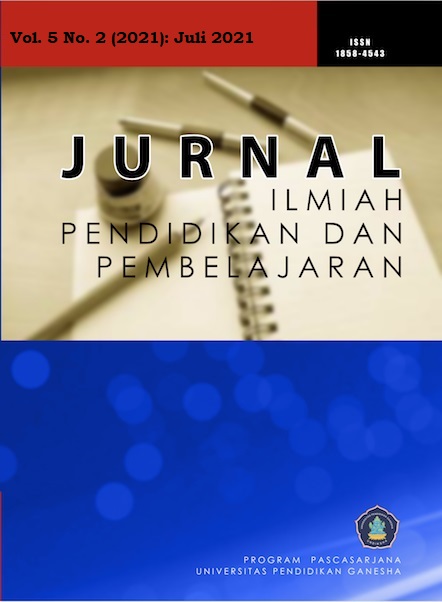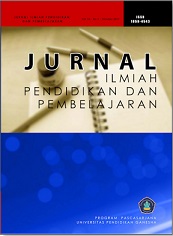Mindfulness dan Implikasinya dalam Penetapan Tujuan pada Mahasiswa Program Sarjana
DOI:
https://doi.org/10.23887/jipp.v5i2.35567Kata Kunci:
Penetapan Tujuan, Mindfulness, MahasiswaAbstrak
Mahasiswa berada pada masa penting yang berdampak bagi masa depannya, penetapan tujuan menjadi salah satu hal yang akan membantu keberhasilan mahasiswa program sarjana. Penelitian ini bertujuan untuk menganalisis mindfulness dan implikasinya dalam penetapan tujuan pada mahasiswa program sarjana. Jenis penelitian ini merupakan penelitian korelasi dengan metode studi non-eksperimental. Desain dalam penelitian ini merupakan cross-sectional study. Metode pengumpulan data melalui menyebarkan kuesioner untuk mengambil data sebanyak satu kali kepada mahasiswa yang berbeda. Teknik aanalisis menggunakan pendekatan kuantitatif. Sampel penelitian dipilih menggunakan metode convenience sampling. Hasil penelitian menunjukkan kedua variabel memiliki hubungan yang signifikan (r=0,186, p<0,01). Nilai R2 = 0,034 (SE = 0,401) yang menunjukkan bahwa sebesar 3,4% variasi penetapan tujuan dapat dijelaskan oleh variasi kondisi mindfulness pada mahasiswa. Diketahui pula bahwa model regresi ini memiliki nilai F(1, 196) = 6, 928 dan t=2,632; p<0,01 dengan β=0,185. Hasil ini menunjukkan bahwa mindfulness dapat berperan sebagai prediktor penetapan tujuan. Jika dituliskan dalam persamaan regresi, maka formula model regresi adalah Y = 2,632 + 0,095 Mindfulness. Hal tersebut menunjukkan setiap kenaikan kondisi mindfulness pada mahasiswa akan meningkatkan penetapan tujuan sebesar 0,095. Mindfulness memiliki hubungan yang positif signifikan dengan penetapan tujuan. Implikasi penelitian ini dapat memberikan dampak kepada mahasiswa dalam meningkatkan keberhasilan mahasiswa dalam menyelesaikan studi di perguruan tinggi.
Referensi
Arnett, J. J. (2000). Emerging adulthood: A theory of development from the late teens through the twenties. American Psychologist, 55(5), 469–480. https://doi.org/10.1037/0003-066X.55.5.469.
Arnett, J. J. (2007). Emerging Adulthood: What Is It and What Is It Good For? Child Development Perspectives, 1(2), 68–73.
Baltes, P. B. (1997). On the Complete Architecture of Human Ontogeny; Selection, Optimization, and Compensation as Foundation of Developmental Theory. American Psychologist, 52 (4)(4), 366–380. https://doi.org/10.1037/0003-066X.52.4.366.
Bandura, A., & Locke, E. A. (2003). Negative self-efficacy and goal effects revisited. Journal of Applied Psychology, 88(1), 87–99. https://doi.org/10.1037/0021-9010.88.1.87.
Bishop, S. R., Lau, M., Shapiro, S., Carlson, L., Anderson, N. D., Carmody, J., Segal, Z. V., Abbey, S., Speca, M., Velting, D., & Devins, G. (2004). Mindfulness: A proposed operational definition. Clinical Psychology: Science and Practice, 11(3), 230–241. https://doi.org/10.1093/clipsy/bph077.
Boker, S. M. (2013). Selection, Optimization, Compensation, and Equilibrium Dynamics. Journal of Gerontopsychology and Geriatric Psychiatry, 26(1), 61–73. https://doi.org/10.1024/1662-9647/a000081.
Brown, K. W., & Ryan, R. M. (2003). The Benefits of Being Present: Mindfulness and Its Role in Psychological Well-Being. Journal of Personality and Social Psychology, 84(4), 822–848. https://doi.org/10.1037/0022-3514.84.4.822.
Brown, K. W., Ryan, R. M., & Creswell, J. D. (2007). Mindfulness: Theoretical foundations and evidence for its salutary effects. Psychological Inquiry, 18(4), 211–237. https://doi.org/10.1080/10478400701598298.
Brown, K. W., West, A. M., Loverich, T. M., & Biegel, G. M. (2011). Assessing Adolescent Mindfulness: Validation of an Adapted Mindful Attention Awareness Scale in Adolescent Normative and Psychiatric Populations. Psychological Assessment, 23(4), 1023–1033. https://doi.org/10.1037/a0021338.
Clements, A. J., & Kamau, C. (2018). Understanding students’ motivation towards proactive career behaviours through goal-setting theory and the job demands–resources model. Studies in Higher Education, 43(12), 2279–2293. https://doi.org/10.1080/03075079.2017.1326022.
Crane, C., Jandric, D., Barnhofer, T., & Williams, J. M. G. (2010). Dispositional Mindfulness , Meditation , and Conditional Goal Setting. Mindfulness, 1, 204–214. https://doi.org/10.1007/s12671-010-0029-y.
Creswell, J. D. (2017). Mindfulness Interventions. Annual Review of Psychology, 68(September), 491–516. https://doi.org/10.1146/annurev-psych-042716-051139
Deci, E. L., & Ryan, R. M. (2000). The “ What ” and “ Why ” of Goal Pursuits : Human Needs and the Self-Determination of Behavior. Psychological Inquiry, 11(4), 227–268.
Deci, E. L., & Ryan, R. M. (2008). Self-determination theory: A macrotheory of human motivation, development, and health. Canadian Psychology, 49(3), 182–185. https://doi.org/10.1037/a0012801.
Felver, J. C., Celis-de Hoyos, C. E., Tezanos, K., & Singh, N. N. (2016). A Systematic Review of Mindfulness-Based Interventions for Youth in School Settings. Mindfulness, 7(1), 34–45. https://doi.org/10.1007/s12671-015-0389-4.
Frank, P., Fischer, D., & Wamsler, C. (2020). Mindfulness , Education , and the Sustainable Development Goals. October 2019. https://doi.org/10.1007/978-3-319-69902-8.
Freund, A. M., & Baltes, P. B. (2002). Life-Management Strategies of Selection , Optimization , and Compensation : Measurement by Self-Report and Construct Validity. Journal of Personality and Social Psychology, 82(4), 642–662. https://doi.org/10.1037//0022-3514.82.4.642.
Grégoire, S., Bouffard, T., & Vezeau, C. (2012). Personal goal setting as a mediator of the relationship between mindfulness and wellbeing. International Journal of Wellbeing, 2(3), 236–250. https://doi.org/10.5502/ijw.v2.i3.5.
Howard, K. A. S., Ferrari, L., Nota, L., Solberg, V. S. H., & Soresi, S. (2009). The relation of cultural context and social relationships to career development in middle school. Journal of Vocational Behavior, 75(2), 100–108. https://doi.org/10.1016/j.jvb.2009.06.013.
Jarukitisakul, C. (2018). The Role of Mindfulness in Identify Development and Goal-Setting in Emerging Adults. Boston University.
Knecht, M., & Freund, A. M. (2016). The use of selection, optimization, and compensation (SOC) in goal pursuit in the daily lives of middle-aged adults adults. European Journal of Developmental Psychology, 1–17. https://doi.org/10.1080/17405629.2016.1207518.
Kristin, F. (2016). Analisis model pembelajaran discovery learning dalam meningkatkan hasil belajar siswa SD. Jurnal Pendidikan Dasar PerKhasa.
Latham, G. P., & Locke, E. A. (1991). Self-regulation through goal setting. Organizational Behavior and Human Decision Processes, 50(2), 212–247. https://doi.org/10.1016/0749-5978(91)90021-K.
Levesque, C., & Brown, K. W. (2007). Mindfulness as a moderator of the effect of implicit motivational self-concept on day-to-day behavioral motivation. Motivation and Emotion, 31(4), 284–299. https://doi.org/10.1007/s11031-007-9075-8.
Shapiro, S. L., Carlson, L. E., Astin, J. A., & Freedman, B. (2006). Mechanisms of Mindfulness ᮢ. Journal of Clinical Psychology, 62(3), 373–386. https://doi.org/10.1002/jclp.
Smyth, A. P. J., Werner, K. M., Milyavskaya, M., Holding, A., & Koestner, R. (2020). Do mindful people set better goals? Investigating the relation between trait mindfulness, self-concordance, and goal progress. Journal of Research in Personality, 88(August). https://doi.org/10.1016/j.jrp.2020.104015.
Strauss, K., Griffin, M. A., & Parker, S. K. (2012). Future work selves: How salient hoped-for identities motivate proactive career behaviors. Journal of Applied Psychology, 97(3), 580–598. https://doi.org/10.1037/a0026423.
Strick, M., & Papies, E. K. (2017). A Brief Mindfulness Exercise Promotes the Correspondence Between the Implicit Affiliation Motive and Goal Setting. Personality and Social Psychology Bulletin, 43(5), 623–637. https://doi.org/10.1177/0146167217693611.
Taylora, G., AlpertbT, J., Franklin, L. B., & Carma, W. (2021). Streaming mindfulness: Well-being and mindfulness among subscribers to a video streaming service. Internet Interventions, 25, 100419. https://doi.org/10.1016/j.invent.2021.100419.
Unduhan
Diterbitkan
Cara Mengutip
Terbitan
Bagian
Lisensi
Authors who publish with the Jurnal Ilmiah Pendidikan dan Pembelajaran (JIPP) agree to the following terms:
- Authors retain copyright and grant the journal the right of first publication with the work simultaneously licensed under a Creative Commons Attribution License (CC BY-SA 4.0) that allows others to share the work with an acknowledgment of the work's authorship and initial publication in this journal.
- Authors are able to enter into separate, additional contractual arrangements for the non-exclusive distribution of the journal's published version of the work (e.g., post it to an institutional repository or publish it in a book), with an acknowledgment of its initial publication in this journal.
- Authors are permitted and encouraged to post their work online (e.g., in institutional repositories or on their website) prior to and during the submission process, as it can lead to productive exchanges, as well as earlier and greater citation of published work. (See The Effect of Open Access)










